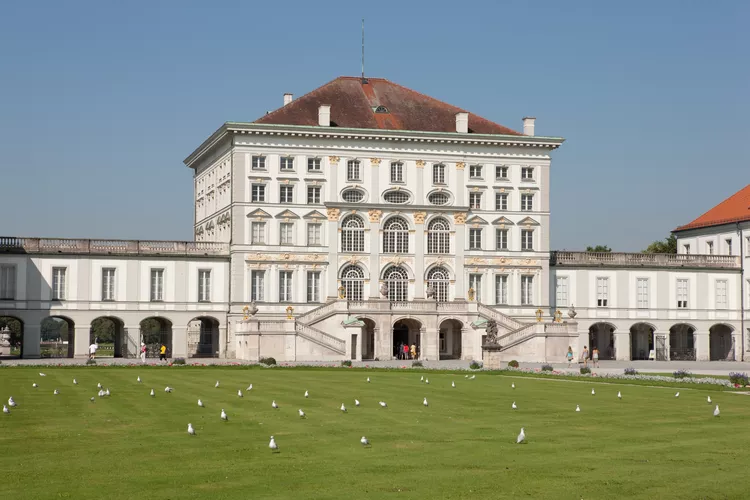Nymphenburg Palace in Munich: A Baroque Gem
Hundreds of thousands of visitors flock to this baroque palace in Munich every year. Nymphenburg Palace (Schloss Nymphenburg) stands as one of the city’s top sights and one of the largest royal palaces in Europe. This “Castle of the Nymph” showcases German history and is a not-to-miss attraction in Bavaria.
1. History of Nymphenburg Palace
Nymphenburg Palace was constructed as a summer residence for the Wittelsbach family in 1664. Its ornate design originates from a love token by prince-electoral Ferdinand Maria to Henriette Adelaide of Savoy following the birth of their long-awaited heir, Maximilian II Emanuel.
Local materials like limestone from Kelheim were utilized, but the original vision was crafted by Italian architect Agostino Barelli. Over time, the palace expanded with additional pavilions, connecting gallery wings, and various stylistic updates as trends evolved. Maximilian II Emanuel made many changes, alongside contributions from others. In 1716, Joseph Effner completely transformed the facade into a French Baroque style, enhancing its grandeur.
Significant historical events unfolded within these walls, including the births of Maria Antonia in 1724 and Maria Anna Josepha in 1734. Charles Albert resided and died here as Holy Roman Emperor, while King Max I Joseph passed away in 1825. His great-grandson, King Ludwig II, famed for Neuschwanstein, was born here in 1845.
In 1792, Elector Charles Theodor opened the grounds to the public, allowing everyone to admire the magnificent landscape—a tradition that continues today. Visitors can appreciate a range of decor styles, from original baroque to rococo and neoclassical design.
Moreover, Nymphenburg Palace remains a residence for modern royalty, currently serving as the home and chancery for Franz, Duke of Bavaria, who has ties to the British monarchy.
:max_bytes(150000):strip_icc():format(webp)/nymphenburg-palace--17th-century--the-great-hall--baroque-style--munich--germany-112188357-5c29ab0646e0fb0001c7d862.jpg)
2. Main Attractions of Nymphenburg Palace
The Schlossmuseum allows access to the palace’s interior, including the royal apartments, central pavilion, north and south galleries, and garden pavilions. While there are numerous historically significant sights at Nymphenburg Palace, some must-see attractions include:
- Steinerner Saal: This grand three-story hall showcases stunning ceiling frescoes by Johann Baptist Zimmermann and F. Zimmermann, featuring Helios in his chariot at the center.
- Schönheitengalerie: Located in a small dining room of the Inner Southern Pavilion, this gallery contains 36 portraits created by court painter Joseph Karl Stieler, depicting the most beautiful women in Munich, including the famed Lola Montez.
- Queen’s Bedroom: This room, where King Ludwig II was born on August 25, 1845, features original mahogany furniture from 1815 along with busts of Crown Prince Ludwig and his brother Otto.
- Palace Chapel: The outer northern pavilion houses the palace chapel, adorned with remarkable ceiling paintings depicting the life of St. Mary Magdalene.
Museums in Nymphenburg Palace
- Marstallmuseum (Carriage Museum) – Located in the former royal stables, this museum displays one of Europe’s finest coach collections, including the French Rococo Coronation Coach.
- Porzellanmuseum München – Showcases the Bäumel Collection of porcelain from the 18th to 20th centuries.
- Museum Mensch und Natur (Museum of Man and Nature) – A natural history museum situated in the north wing.
- Erwin von Kreibig-Museum – Exhibits dedicated to the local sculptor are displayed at the South Schlossrondell.
Palace Grounds and Gardens
The sprawling 490-acre park surrounding the palace is a focal point, transforming from an Italian garden to a French style and then to the English design seen today, crafted by Friedrich Ludwig von Sckell. Although simpler than its Baroque predecessor, the garden remains breathtaking.
Notable park structures include the Pagodenburg, Badenburg, Magdalenenklause, and Amalienburg, exemplifying German design influences. The Apollotempel is a striking neoclassical temple from the 1860s.
Water features, including cascading waterfalls and geysers, enhance the park’s beauty, with cast iron pumps operating for over 200 years—Europe’s oldest continuously working machines.
Summer visitors can enjoy the serene ambiance with gondola rides on the lakes flanking the canal. The park is a crucial refuge for Munich’s residents and surrounding wildlife, including deer, rabbits, and swans.
3. Visitor Information for Nymphenburg Palace
- Website: schloss-nymphenburg.de/englisch/palace
- Address: Schloß Nymphenburg 1, 80638 Munich
- Phone: +49 089 179080
- Hours: April through mid-October daily 9:00 AM to 6:00 PM; Mid-October through March daily 9:00 AM to 4:00 PM (Some buildings are only accessible in summer).
Tickets: Tickets are priced at 11.50 euros in summer and 8.50 euros in winter. These tickets provide entrance to the palace, Marstallmuseum, Porzellanmuseum München, and the park palaces (note that park palaces are closed in winter). Audio guides are available in multiple languages for a nominal fee.
How to Get to Nymphenburg Palace
Schloss Nymphenburg is conveniently accessible from central Munich via public transport, which links to major roadways.
Public Transport: Take the S-Bahn to “Laim,” then a bus to “Schloss Nymphenburg”; alternatively, take the U-Bahn to “Rotkreuzplatz” and then a tram to “Schloss Nymphenburg.”
Driving: Access via motorway A 8 (Stuttgart – Munich), A 96 (Lindau – Munich), A 95 (Garmisch – Munich), and A 9 (Nuremberg – Munich). Look for signs to “Schloss Nymphenburg.” Parking is available for cars and buses at the palace.




